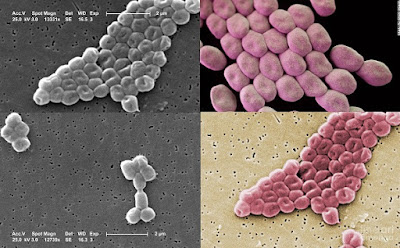While Minister of Health, Dr. Fenton Ferguson has now been
ordered to release the Health Audit on Friday November 6th 2015 as reported in
the article “PM
Gives Instruction for Public Release of Health Sector Audit Report”,
published November 5, 2015 By OPM Communications Unit, The Jamaica Information Service, yet another
outbreak of a deadly Bacteria has occurred.
This time it's acinetobacter and the outbreak has occured at
the KPH (Kingston Public hospital) as reported in the article “Bacteria
scare at KPH”, published Thursday, November 05, 2015 by Alphea Saunders, The Jamaica Observer.
So far only three (3) adults have been infected in an
outbreak that mimics the MRSA (Methicillin-resistant Staphylococcus Aureus) outbreak
occurring at the Bustamante Hospital for children as reported in my blog article
entitled “MRSA
at Bustamante Hospital for Children since July 2015 - Why continued Drought
will see increase Bacterial Infections”.
SERHA (South East Regional Health Authority) has been
collaborating with the Kingston and St Andrew Public Health Department, the
National Public Health Lab and the Ministry of Health on a strategy to control
the spread of acinetobacter as reported in the article “SERHA
monitoring cases of multi-drug resistant bacteria at KPH”, published
Thursday, November 05, 2015, The
Jamaica Observer.
They plan to conduct an epidemiological investigation as
part of spearheading this plan. The acinetobacter may become the fourth (4)
bacterial infection after nineteen (19) out of forty five (45) Babies infected
with Klebsiella and Serratia bacterial had died since June 2015 as reported in my
blog article
entitled “19
Babies now dead from Klebsiella and Serratia bacterial infections - How More
Babies will Die as Drought continues”.
So what is this latest bacteria acinetobacter? And should
the general population be worried?
Acinetobacter
infection at Kingston Public Hospital - Why Fourth Major infection for
Christmas Drought 2015
Acinetobacter belongs to the genus of Gram-negative bacteria
under the class of Gammaproteobacteria. Acinetobacter species are oxidase-negative
and do not have flagella, so they cannot move.
They usually occur in colonies under magnification and are
actually helpful in the mineralization of aromatic compounds such as esthers,
ketones and aldehydes.
Within the hospital setting all species of acinetobacter are
harmful to humans, but the particular species Acinetobacter baumannii is most
commonly responsible for cases of infection within a hospital setting. However,
samples will have to be collected by SERHA, the Kingston and St Andrew Public
Health Department and the National Public Health Lab in order to identify the particular
strain of acinetobacter involved in this infection.
Acinetobacter has a high resistance to conventional
antibiotics and there is currently a shortage of the appropriate antibiotics in
Jamaica. This may become a serious outbreak that may spread outside of the KPH
and into the general public, as despite the implementation of safeguards to
prevent persons coming in contact with the infected, many nurses work on
multiple Wards.
Like MRSA, acinetobacter spread via contact with surfaces
within a hospital setting that have colonies of the bacteria growing due to a
lack of use of anti-septics. It’ll also affect persons who have weak immune
system i.e. babies, children suffering from an illness or elderly persons with
other health problems.
However, it has a lot more in common with the Coxsackie
Virus as described in my blog article
entitled “313 Cases of Hand, Foot and Mouth Disease in
Jamaican Schools - Why the Coxsackie Virus thrives in a Drought” acinetobacter
as it originates from contact with soil, where it mainly lives.
Given it origins, its sudden appearance within the KPH
implying that the spread is due to a lack of hygiene on the part of the nurses
within the KPH as well as people visiting on the KPH Ward.
The fact that its soil based bacteria suggests that its
origin may be from either patients or doctors from the country who either work
on or live on a farm. It may also be due to cats on the Ward, as they’ve been
known the wander around the Ward; digging in the soil, the Acinetobacter may be
taking a ride on their fur, mouth and claws, which they use to spread the
disease around via contact with patients!
However, unlike Klebsiella and Serratia and MRSA, there are
suitable pharmaceuticals that can treat the Acinetobacter infection and so far,
no one has died as noted in the article “Infectious
Outbreak At KPH, No Deaths”, Published Thursday November 5, 2015, The Jamaica Gleaner.
Already the three (3) infected persons are recovering and
the infection is under control. This is thanks to reorientation of medical
staff since Tuesday November 3rd 2015, increased use of anti-septics and having
medical staff practice barrier nursing, a set of stringent procedures designed
to protect medical staff against highly infectious disease.



No comments:
Post a Comment
Please register and leave you comments. For contact, leave an email or phone number and I'll be sure to get back to you.